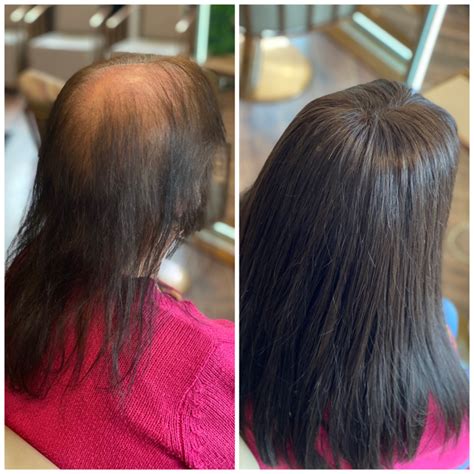As many as 30 million women in the United States struggle with hair loss[1], a common issue impacting women of all ages and ethnicities. From thinning hair to bald patches, hair loss affects confidence and self-esteem, leading to emotional distress and social anxiety. Fortunately, advanced hair replacement techniques offer effective solutions to restore hair loss and empower individuals to regain their confidence.

Hair replacement technologies have evolved significantly over the years, providing various options to meet unique needs.
Hairpieces and Wigs
Hairpieces and wigs are non-surgical solutions that offer immediate coverage for hair loss. Made from natural or synthetic hair, they are designed to blend seamlessly with the client’s natural hair. Hairpieces are smaller and cover only specific areas, while wigs are full garments that completely cover the head.
Hair Extensions
Hair extensions involve adding strands of donor hair to the existing hair to increase length, volume, or fullness. They are a popular choice for women with thinning hair or who wish to change their hairstyle without damaging their natural hair.
Hair Transplantation
Hair transplantation is a surgical procedure that involves transplanting hair follicles from one part of the scalp, typically the donor area at the back of the head, to the balding area. New hair grows from the transplanted follicles, providing permanent hair restoration.
When selecting a hair replacement solution, it’s important to consider several factors:
- Type of Hair Loss: Determine the cause and pattern of hair loss to choose the most appropriate solution.
- Personal Preferences: Consider individual lifestyle, hair type, and maintenance requirements for a comfortable and practical solution.
- Budget: Hair replacement costs vary, so it’s important to research different options and find a solution that fits financial constraints.
- Lack of Confidence: Hair loss can damage self-esteem and lead to social isolation. Hair replacement restores confidence and empowers individuals to feel comfortable in their own skin.
- Hiding Concealing: Women often feel the need to hide their hair loss, leading to use of scarves, hats, or wigs. Hair replacement offers a more permanent solution and eliminates the need for constant concealment.
- Regaining Youthful Appearance: Hair loss can add years to one’s appearance. Hair replacement restores a youthful appearance and enhances overall self-perception.
- Emotional Distress: Hair loss can trigger feelings of grief, shame, and depression. Hair replacement provides a way to cope with these emotions and regain a sense of well-being.
- Ignoring the Cause: It’s crucial to determine the underlying cause of hair loss to receive proper treatment.
- Choosing the Wrong Type: Selecting an inappropriate hair replacement solution can lead to discomfort or unsatisfactory results.
- Neglecting Maintenance: Hair replacement solutions require regular maintenance and care to maintain their appearance and longevity.
- Overspending: Hair replacement costs can vary significantly. Avoid getting into debt for a solution that doesn’t meet your needs.
- Going it Alone: Seek professional advice from a dermatologist or hair replacement specialist to make informed decisions and achieve optimal results.
Table 1: Types of Hair Loss in Women
| Type | Cause | Symptoms |
|---|---|---|
| Androgenetic Alopecia | Genetic | Gradual thinning of hair on the scalp, starting from the top of the head |
| Alopecia Areata | Autoimmune | Suddenly developing round or oval patches of hair loss |
| Telogen Effluvium | Stress or illness | Temporary hair loss that occurs 2-3 months after the triggering event |
| Anagen Effluvium | Chemotherapy or radiation | Rapid hair loss within days or weeks as a side effect of treatment |
Table 2: Advantages and Disadvantages of Hair Replacement Options
| Option | Advantages | Disadvantages |
|---|---|---|
| Hairpieces and Wigs | Immediate coverage | Not permanent |
| Hair Extensions | Non-surgical | Can damage natural hair |
| Hair Transplantation | Permanent | Involves surgery |
Table 3: Factors to Consider When Choosing a Hair Replacement Solution
| Factor | Considerations |
|---|---|
| Type of Hair Loss | Determine the cause and pattern of hair loss to select the most appropriate solution. |
| Personal Preferences | Consider individual lifestyle, hair type, and maintenance requirements. |
| Budget | Research different options and find a solution that fits financial constraints. |
Table 4: Professional Resources for Hair Replacement
| Resource | Contact |
|---|---|
| American Academy of Dermatology | https://www.aad.org |
| International Society of Hair Restoration Surgery | https://www.ishrs.org |
| Hair Loss Association | https://www.hairloss.org |
Hair replacement for women offers effective solutions to restore hair loss and empower individuals to regain their confidence. Advanced technologies provide a range of options to meet unique needs. By understanding the different methods, considering personal preferences and motivators, and avoiding common mistakes, women can make informed decisions and find the best solution to restore their hair and enhance their well-being.
[1] Hair Loss in Women. (n.d.). American Academy of Dermatology Association. https://www.aad.org/conditions/hair-loss/hair-loss-women
